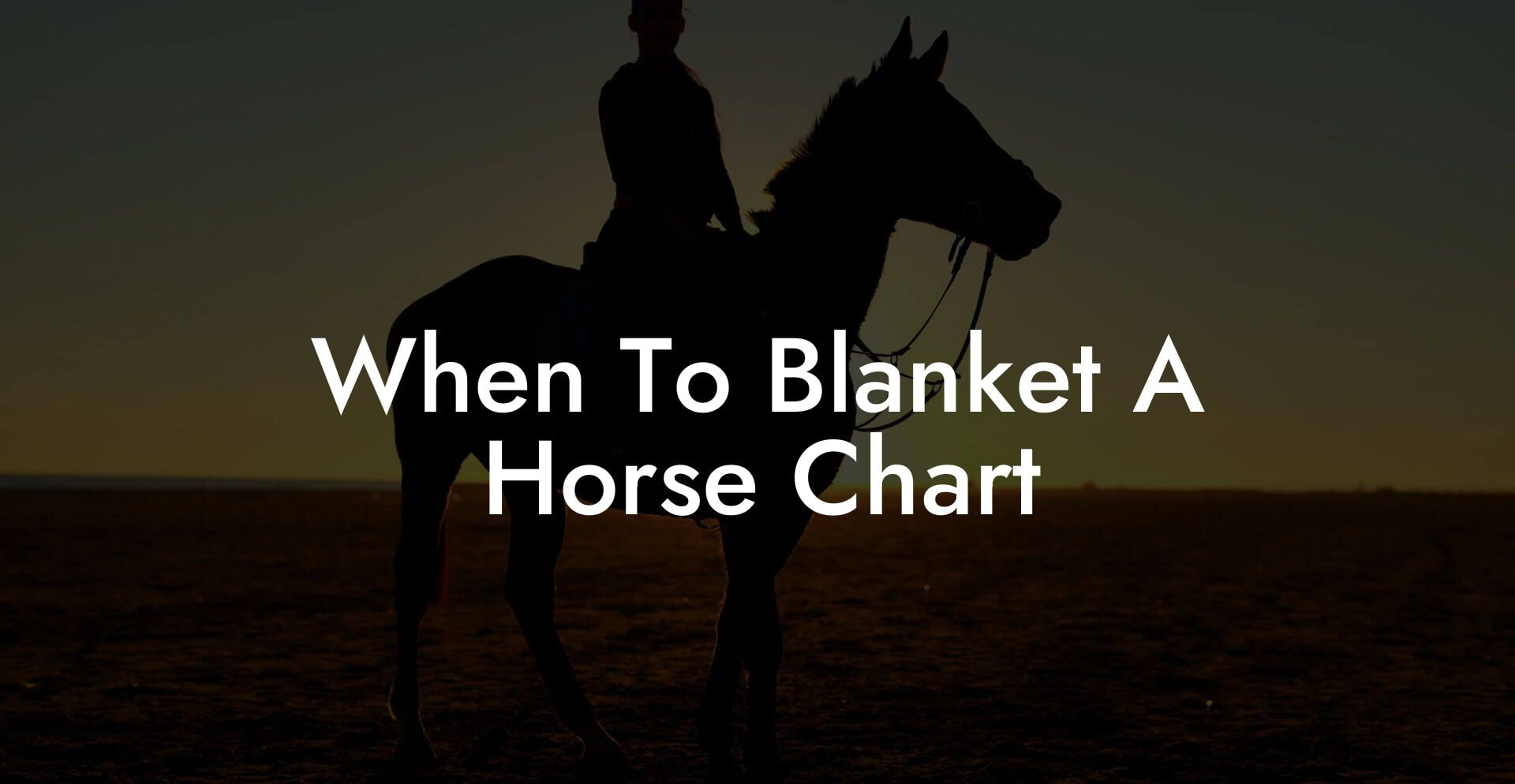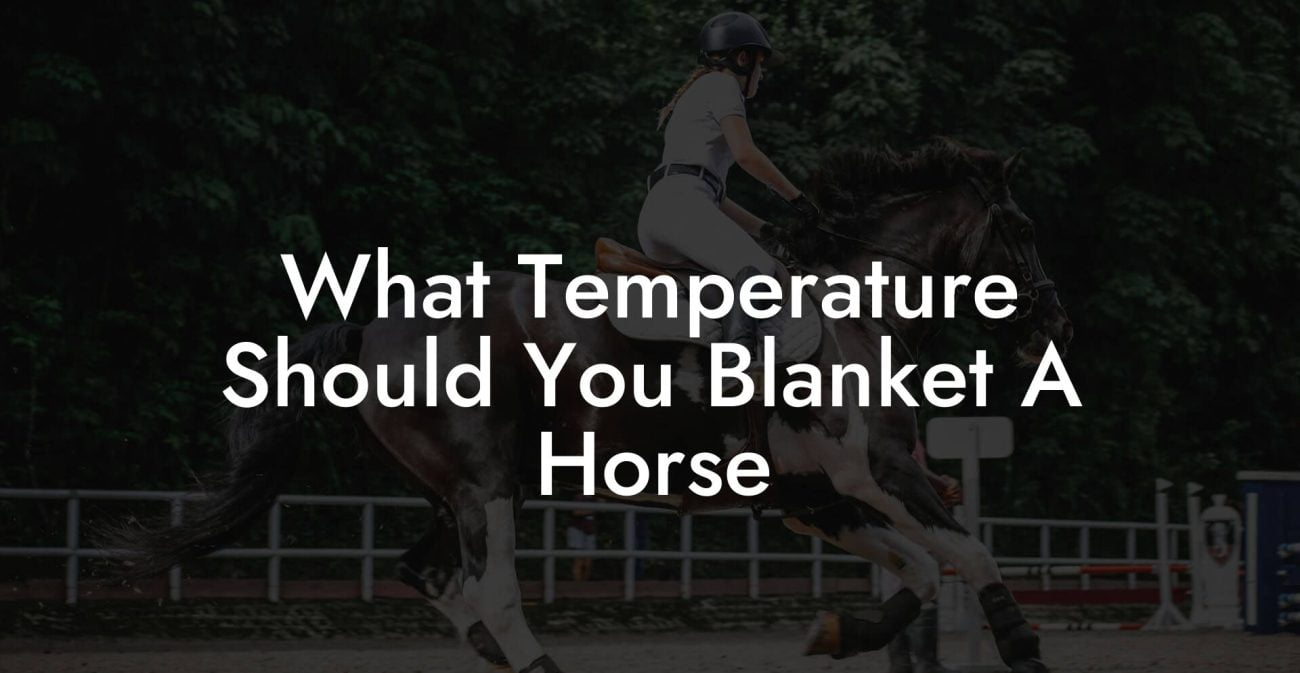Ever found yourself mid-scroll on Instagram, wondering if your horse is shivering in the cold like you do during winter mornings in your oversized hoodie? If you’ve ever considered the art and science behind knowing exactly when to blanket a horse without overdoing it or leaving them shivering, you’re in the right place. Here, we dive headfirst into the detailed yet delightfully readable world of horse blanketing, complete with charts, insider tips, and plenty of Gen-Z and millennial-approved humor to keep things as fun as they are informative.
Quick Links to Useful Sections
- Understanding the Basics of Blanketing a Horse
- Decoding the “When To Blanket A Horse” Chart
- Factors to Consider When Deciding to Blanket Your Horse
- Weather Conditions
- Coat Thickness and Condition
- Activity Level
- Age and Health
- Time of Day and Microclimates
- How Temperature and Weather Affect Your Horse’s Comfort
- Blanket Options: Choosing the Right Type for Your Horse
- Stable Blankets
- Turnout Blankets
- Coolers and Swim Sheets
- Creating a Personalized Blanket Routine for Your Horse
- Common Mistakes and How to Avoid Them
- Over-Blanketing
- Blanketing in Unpredictable Weather
- Poor Fit and Incorrect Blanket Type
- Integrating Technology: Modern Tools for Traditional Blanketing Decisions
- Resources and Community Support: Your Next Steps
- Case Studies: Real-Life Blanketing Success Stories
- The Chill of the Unexpected Storm
- No Blanket, No Problem?
- Blanketing Gone Wrong
- Customizing Your Equine's Blanketing Plan: Tips and Tricks
- Keep a Weather Diary
- Test Different Blankets
- Regular grooming
- Consult Experts
- Integrating Social Media and Modern Insights
- Equipping Yourself with the Right Tools and Knowledge
- Your Journey to Confident, Comfy Horse Care
- Frequently Asked Questions about When To Blanket A Horse
- Embracing a New Era in Equine Care
Understanding the Basics of Blanketing a Horse
Let’s kick things off with the basics: why do we even need to blanket our horses? While horses come with an amazing natural coat that changes with the season, sometimes Mother Nature isn’t on your side. Unlike us humans who can always find another sweater in our closet, horses don’t exactly have a backup wardrobe. Their coats grow and shed depending on weather conditions, and that’s where the “when to blanket a horse chart” comes in.
Plain and simple, a horse blanket is like that extra layer of security on a chilly day. It helps maintain their body temperature, protects them from pesky insects, and even shields them from harsh winds or heavy rain. But here’s the kicker: every horse is unique. Factors such as breed, age, activity level, and even personality can influence whether your four-legged friend needs extra insulation or the freedom to let their natural coat do its thing.
In this guide, we’ll cover everything from reading the chart correctly to understanding the intricate balance of temperature, moisture, and horse temperament. Whether you’re a seasoned equestrian or a curious newbie, grab your favorite snack (and maybe your phone, because you’ll want to bookmark these tips), and let’s get started.
Decoding the “When To Blanket A Horse” Chart
At the heart of every equestrian’s decision-making process when it comes to blanketing is the “when to blanket a horse chart.” Think of it as a cheat sheet that helps you decide if it’s time to cloak your equine pal in some cozy fabric or let them bask in the glory of their natural hair coat.
These charts are designed to consider several factors: ambient temperature, wind chill, humidity, and how thick or thin your horse’s coat is at a given time of year. Modern charts sometimes even integrate data specific to horse breeds and their typical hair growth patterns. For example, a Norwegian Fjord horse might handle winter chills better than a tropical-bred Thoroughbred.
The chart typically displays temperature zones with corresponding recommendations. For instance:
- Temperatures above 45°F (7°C): Most horses can go without a blanket as their coat is designed to handle milder climates.
- Between 32°F and 45°F (0°C and 7°C): Consider a lightweight blanket, especially if the wind is howling.
- Below 32°F (0°C): A heavy-duty blanket might be necessary, but every horse is different, and the decision should hinge on the condition of their hair coat and body condition.
Remember, this is a guide and not a strict rule. Just as you adjust your outfit for unexpected weather changes, you should also monitor your horse’s behavior and condition. If your horse seems unusually restless, has cold ears, or is shivering, it might be a sign that they’re feeling the chill, even if the numbers on the chart seem supportive of a no-blanket day.
Factors to Consider When Deciding to Blanket Your Horse
Blanketing a horse isn’t a one-size-fits-all affair. Here, we break down the main factors you should consider before deciding whether or not to drape your equine companion in a cozy cover.
Weather Conditions
The weather is the VIP guest at every blanketing decision. Temperature is crucial, but don’t overlook wind chill, humidity, and precipitation. A brisk wind can make a seemingly warm day feel icy, while damp conditions can sap your horse’s natural insulation.
Coat Thickness and Condition
Horses naturally grow a thicker coat as the temperatures drop, a process known as “winter coat development.” The effectiveness of this coat can vary based on breed, nutrition, and overall health. If your horse has a lush, thick winter coat, they might be less dependent on an additional blanket.
Activity Level
Consider how active your horse is. A horse that’s out on long trail rides or in vigorous training generates more body heat and might be less sensitive to cooler temperatures. Conversely, a horse that spends most of its time in a stable or a paddock might need the extra warmth provided by a blanket.
Age and Health
Older horses or those with health conditions such as arthritis, poor circulation, or other metabolic concerns might require extra thermal protection. Even if the “when to blanket a horse chart” suggests that the weather is mild enough, individual health considerations tip the scale in favor of blanketing.
Time of Day and Microclimates
Temperature can vary significantly between the early morning, midday, and evening. Additionally, local microclimates, areas in your barn or pasture that are wind-sheltered or exposed, can influence how cold your horse feels. A horse might be perfectly comfortable during a sunny afternoon, but shiver under the stars.
By integrating these factors with your trusty “when to blanket a horse” chart, you form a more complete and nuanced decision-making tool that says, “Yes, it’s chilly out there, let’s bundle up our buddy!” rather than sticking blindly to numbers.
How Temperature and Weather Affect Your Horse’s Comfort
You might be wondering: can a horse really get cold? The answer is a resounding yes, just like us when we forget our scarves on a frost-bitten morning. Horses are equipped with a natural insulation system, but it’s not an all-weather guarantee. If the wind is blowing too hard or rain is coming down in sheets, your horse might need some extra warmth.
Temperature: It’s the starting point for any blanketing decision. Horses generally regulate well in moderate temperatures, but when the thermometer dips, the extra layer of a blanket can make a world of difference. Keep that chart handy and remember: a drop in temperature by just a few degrees might push your decision from “no blanket” to “blanket time.”
Wind Chill: Wind can strip away the natural heat that a horse’s coat provides. Even on a day that seems acceptable by the numbers, a fierce wind can create a chill factor that leaves your horse shivering. Always take wind chill into account, your horse’s ears might be the first to let you know something’s off.
Humidity and Precipitation: Damp conditions can cause even the thickest coat to lose its insulating properties. Rain or heavy dew might signal that a blanket is necessary, even if the temperature appears to be in the “safe zone” according to your chart.
Monitoring these environmental cues alongside your chart can help ensure that you’re not caught off guard by a sudden weather change that leaves your horse uncomfortable.
Blanket Options: Choosing the Right Type for Your Horse
Not all horse blankets are created equal. There’s a smorgasbord of options available, and the right choice depends on the conditions and your horse’s specific needs. Let’s break down the primary types:
Stable Blankets
These are designed to be used while your horse is in the stable. They often feature a lightweight, breathable material that provides some insulation without overheating your horse during periods of inactivity. Perfect for cool nights or overly air-conditioned barns.
Turnout Blankets
When your horse is out and about in a paddock or pasture, a turnout blanket can help protect against wind, light rain, and dew. They’re typically waterproof or water-resistant and offer a snug fit to keep the blanket secure while your horse is on the move.
Coolers and Swim Sheets
Believe it or not, sometimes your horse might actually overheat. Coolers are designed to help regulate temperature after a hard workout by allowing air to circulate and your horse to cool down gradually. Swim sheets, on the other hand, are essentially lightweight, water-repellent blankets that protect against the elements on cooler days without trapping too much heat.
Choosing the right blanket isn’t just about the weather, it’s about your horse’s personal comfort and needs. As you master the art of reading the “when to blanket a horse chart,” remember that the ultimate goal is to keep your horse comfortable, healthy, and ready to gallop off into the sunset (or just enjoy a calm day in the pasture).
Creating a Personalized Blanket Routine for Your Horse
Just as you wouldn’t wear the same outfit every day, your horse might need a variable blanketing schedule tailored to their unique characteristics. A well-thought-out routine not only ensures comfort but also protects the integrity of your horse’s natural coat.
Start by assessing your horse’s specific needs:
- Breed-Specific Considerations: Some breeds, like Icelandic Horses or certain draft breeds, have natural insulation perks that might reduce the need for heavy blanketing, while lighter-coated breeds might require extra protection.
- Age and Health: Older horses or those with specific health concerns may benefit from a warmer, more secure blanket. Conversely, younger, more active horses may thrive without one most of the time.
- Daily Routine and Exposure: Does your horse spend most of the time outdoors, or are they primarily stabled? Horses that are frequently exposed to fluctuating weather conditions might need a more adaptive blanketing plan.
Once you’ve answered these questions, map out a schedule that aligns with the seasonal guidelines from your blanket chart. For example, during the autumn months as temperatures begin to drop, consider gradually increasing the frequency of blanketing, even if the chart suggests only a lightweight cover, to help your horse transition smoothly into winter.
Use digital tools or even a good old-fashioned chart that you can update weekly. Many modern horse care apps allow you to log temperature trends and your horse’s behavior, sending you gentle reminders when it might be time to grab that blanket.
Remember, a personalized approach isn’t set in stone. Keep an eye on your horse’s behavior, if they seem more comfortable, relaxed, and ready for their daily adventures, you’re on the right track. If not, adjust. After all, blanketing your horse is as much about intuition and observation as it is about following a chart.
Common Mistakes and How to Avoid Them
Even the most seasoned horse lovers occasionally slip up when it comes to blanketing. Let’s explore some of the most common pitfalls and equip yourself with the knowledge to avoid them.
Over-Blanketing
The first and most common mistake is over-blanketing, covering your horse with heavy blankets when they’re already producing a well-insulated winter coat. This not only risks overheating but can also interfere with their natural shedding process. Remember, less is often more; trust your chart and your observations.
Blanketing in Unpredictable Weather
Relying solely on the chart without taking microclimates and sudden weather changes into account might leave you unprepared. One minute it might be a chilly but clear day, and the next, a sudden windstorm can leave your horse gasping in the cold. Keep an eye on real-time weather updates and be flexible.
Poor Fit and Incorrect Blanket Type
A blanket that doesn’t fit correctly is more of a hassle than a help. Ill-fitted blankets can rub, cause skin irritation, or simply fail to provide the insulation needed. Invest in well-designed blankets that suit your horse’s body shape and intended activity. Whether it’s a turnout blanket or a stable sheet, the right fit is crucial.
Avoiding these mistakes comes down to being observant, proactive, and willing to adjust your approach based on both your chart and your horse’s individual behavior.
Integrating Technology: Modern Tools for Traditional Blanketing Decisions
In a world where your smartphone can track your sleep and your fitness, why not use technology to improve your equine care routine? Just imagine an app that blends weather forecasts, temperature trends, and your “when to blanket a horse chart” to help you decide on the fly. Well, that future is already here for many modern equestrians.
Numerous apps and digital tools can integrate local weather data with your horse’s care schedule. Some even offer reminders and personalized notifications based on the latest trends. This means you never have to second-guess yourself whether your horse needs that extra layer on a brisk morning ride.
Social media and online communities also play a big role in modern horse care. Following trusted equestrian influencers and joining online forums can offer real-time advice and shared experiences that supplement your own observations and the recommendations provided by your chart.
Embracing technology doesn’t replace the old-fashioned eye-test and intuition, but it certainly helps refine your decisions, making the process of blanketing more efficient and connected to your day-to-day lifestyle.
Resources and Community Support: Your Next Steps
While this guide gives you a treasure trove of insights into when and how to blanket your horse, remember that continuous learning and community support are key. Consider tapping into these resources:
- Online Forums: Become part of vibrant communities such as The Chronicle of the Horse forums, Reddit’s r/equestrian, or specialized Facebook groups where you can ask questions, share experiences, and get advice from seasoned horse owners.
- Equestrian Blogs and Podcasts: Subscribe to blogs and podcasts that focus on horse care and management. These resources are often run by experts who share both scientific insights and personal stories that make every piece of advice relatable and actionable.
- Local Equine Centers: Don’t hesitate to consult your local stables, riding clubs, or equine veterinarians. Networking with local professionals can provide personalized recommendations tailored to your region’s climate and your horse’s unique needs.
- Mobile Apps: Explore apps that track weather, temperature trends, and even your horse’s behavior. They can work in tandem with your chart to notify you exactly when the conditions shift.
- Workshops and Seminars: Look out for events hosted by equestrian organizations that cover topics such as seasonal horse care, blanketing, and general equine wellness.
Venturing into these communities not only enhances your knowledge but also keeps you connected to the ever-evolving field of horse care. With every interaction, you’ll gain fresh insights that might refine your approach to using that all-important “when to blanket a horse chart.”
Case Studies: Real-Life Blanketing Success Stories
Sometimes, the best way to learn is through the stories of others who have navigated the blanketing dilemma. Let’s take a look at a few case studies that prove that knowing when to blanket your horse is as much a science as it is an art.
The Chill of the Unexpected Storm
When 22-year-old Alex inherited a spirited Quarter Horse named Star, he was both thrilled and overwhelmed by the intricacies of horse care. One winter evening, a sudden drop in temperature paired with a fierce wind hit his rural property. Star’s usual robust winter coat was visibly damp from a light rain earlier in the day. Applying the guidelines from his trusted “when to blanket a horse chart,” Alex decided on a mid-weight turnout blanket earlier than usual, a decision that saved Star from catching a cold. The result? Star continued to prance around, showcasing both athletic prowess and a surprisingly composed demeanor, as if saying, “Thanks for the extra warmth, Alex!”
No Blanket, No Problem?
In another scenario, experienced horse owner Jamie noted that her mare, Luna, consistently outsmarted the chilly weather. Luna’s coat was thick, and her constant movement during turnout generated ample body heat. In spite of plummeting temperatures, Luna appeared content without a blanket. Jamie learned that understanding her mare’s behavior and trusting the chart (which flagged a “no blanket” zone for highly active horses) were key. This real-life example reaffirms that a tailored approach, rather than a blanket rule applied to all horses, is imperative.
Blanketing Gone Wrong
Over-blanketing can also teach valuable lessons. Veteran horse owner Taylor once blanketed an older gelding, Rusty, every single day despite the chart suggesting only occasional blanketing during milder mornings. Soon enough, Rusty began showing signs of discomfort, including excessive sweating and irritability. Taylor quickly adjusted the schedule and learned that sometimes, less is more. Listening to Rusty’s cues helped restore his comfort and led to a calmer, happier horse.
These case studies highlight that personalized adjustments, informed by data from a reliable “when to blanket a horse chart” and keen observation, can make all the difference. One size does not fit all, every horse has its own rhythm, and the art of blanketing requires you to blend technology, intuition, and care.
Customizing Your Equine's Blanketing Plan: Tips and Tricks
Now that you’re armed with all the knowledge, it’s time to draft your very own, personalized blanketing plan. Here are some actionable tips to help you keep your horse not only warm but also stylishly comfortable:
Keep a Weather Diary
Track daily weather patterns along with observations of how your horse reacts to different conditions. Over time, you’ll notice trends that could help you preemptively decide on whether a blanket is needed.
Test Different Blankets
Experiment with a variety of blanket types, from lightweight turnout sheets to heavy stable blankets, to determine what works best for your horse in various weather scenarios. Assessment isn’t just about the numbers; it’s about the feel, fit, and overall comfort.
Regular grooming
A thorough grooming routine doesn’t just keep your horse looking Insta-ready, it also improves the effectiveness of their natural coat. Regularly brushing out tangles and ensuring a clean coat can increase the insulation properties, making your blanketing routine more flexible.
Consult Experts
Lean on your local trainer, farrier, or veterinarian for advice. Their firsthand experience with horses in your specific geography can offer insights that no generic chart might capture.
By incorporating these practices into your routine, you elevate blanketing from a mundane task to an engaging ritual that strengthens the bond between you and your equine friend.
Integrating Social Media and Modern Insights
Let’s face it, if it’s not trending on TikTok or Instagram, is it even worth discussing? Social media has transformed how equestrians share wisdom. Platforms like TikTok, YouTube, and Instagram reels are brimming with influencers showcasing blanketing hacks, gear reviews, and weather trend analyses.
Following hashtags such as #HorseCare, #EquestrianLife, and #BlanketYourHorse can lead you to bite-sized tips and community-driven insights. These trends not only educate but also create a space where you can share your own stories and learn from others’ experiences.
It’s the perfect blend of old-school expertise and new-age connectivity, making sure that your decisions aren’t just data-driven but also culturally relevant and fun.
Equipping Yourself with the Right Tools and Knowledge
Knowledge is power, and in the world of equine care, being informed about your horse’s needs will always steer you in the right direction. Stock up on resources such as:
- Comprehensive Blanketing Charts: Keep printed or digital copies handy, updated with the latest guidelines taking into account your local weather patterns.
- Temperature and Weather Apps: Use apps like Weather Underground or local meteorological services to get precise forecasts and alerts.
- Equine Health Journals: Document your observations, blanket schedules, and any notable changes in your horse’s demeanor. This journal serves as your personalized data log that you can refer back to during seasonal transitions.
- Community Recommendations: Subscribe to equestrian newsletters and join online webinars hosted by experts. Continuous learning can help refine your innate blanketing sense.
These tools empower you to merge hard data with your personal experience, helping to create a flexible, informed blanketing plan that adapts to your horse’s evolving needs.
Your Journey to Confident, Comfy Horse Care
The world of horse blanketing might seem as complex as decoding your favorite meme, filled with layers of meaning, variable contexts, and ever-changing scenarios. But just like any trending topic on social media, once you break it down, it becomes second nature. By understanding the “when to blanket a horse chart” and integrating it with your own observations, you’re not just following a guideline; you’re crafting a lifestyle that champions both your horse’s comfort and your own peace of mind.
Every horse is unique, and every journey is personal. As you blend traditional methods with modern insights, you’ll discover that caring for your equine companion becomes a harmonious dance between science and art, a dance where you set the rhythm, and your horse sets the pace.
Embrace this journey with humor, curiosity, and a healthy dose of confidence. From keeping tabs on weather forecasts to engaging with vibrant online communities, every step you take makes you a better, more informed equestrian.
So, the next time you find yourself poring over a “when to blanket a horse chart,” remember that you’re not just making a technical decision, you’re showing your horse the love and care they deserve. And really, isn’t that what being an amazing horse owner is all about?
Frequently Asked Questions about When To Blanket A Horse
Below are some of the most common questions we get about blanketing, along with detailed answers to ensure that both you and your horse are always in tip-top shape.
1. What is a “when to blanket a horse chart”?
It’s a guide that helps determine whether your horse needs a blanket based on factors like ambient temperature, wind chill, humidity, and the condition of their coat. This chart provides general recommendations that can be tailored to your horse’s individual needs.
2. How do I know if my horse needs a blanket despite what the chart says?
While the chart provides a useful starting point, always consider your horse’s behavior. If your horse seems uncomfortable, shivers, or has cold ears, it might be a sign that they need additional warmth, even if the chart suggests otherwise.
3. Can technology help me determine the right time to blanket my horse?
Absolutely. Many modern apps combine weather forecasts with equine care tips to provide real-time recommendations. They can even send you alerts when the conditions change unexpectedly.
4. Are there different blanket types for different weather conditions?
Yes, there are stable blankets, turnout blankets, coolers, and swim sheets. Each type is designed to address specific weather conditions and activity levels.
5. How often should I re-assess my horse’s blanketing needs?
Frequent observation is key, daily checks during transitional seasons and weekly reviews during stable weather periods. Always be ready to adjust your plan as temperatures and other conditions change.
6. Can over-blanketing harm my horse?
Yes, it can lead to overheating or interfere with your horse’s natural shedding process. It’s important to follow both the chart and your horse’s cues to avoid overdoing it.
7. What should I do if my horse is an exception to the chart?
Every horse is unique. In such cases, consult with your veterinarian or an equine specialist to develop a customized blanketing routine suited to their specific needs.
Embracing a New Era in Equine Care
The journey to mastering when to blanket your horse brings together science, intuition, and community wisdom in a way that’s both empowering and modern. By merging data from precise temperature readings with the individual quirks of your horse and the latest digital tools, you’re setting a new standard for equine care that’s perfectly in tune with Generation Z and millennial values.
Remember, every scroll through a “when to blanket a horse chart” or a conversation on an Instagram equestrian group is a step toward more confident, informed decision-making. Your horse isn’t just an animal, they’re a living, breathing partner whose comfort and happiness depend on the care you provide.
So, whether you’re juggling between your favorite apps, interacting with a vibrant online community, or simply petting your horse on a crisp morning ride, know that you’re part of a dynamic movement that redefines what it means to be a modern horse owner. Embrace the challenge, trust the process, and let your equine companion thrive in every weather and every moment.
Your journey into the world of horse blanketing isn’t just a checklist of tasks, it’s a continuous cycle of discovery, innovation, and heartfelt connection. Here’s to keeping our horses comfortable, our communities engaged, and our blanketing decisions as bold as our favorite social media trends!













